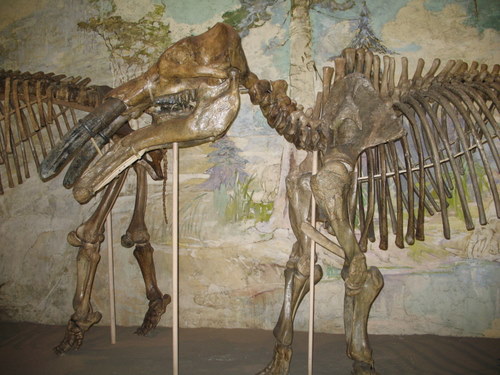Return to Ashfall
Despite nearly $4 a gallon gas and a 6-8 hour drive 16 KABTer’s and their families made the trip to the Morrill Museum in Lincoln, NE, Niobrara State Park and Ashfall State Park this past weekend. Harry, Charlotte, Brad, Carol, Randy, Josie, Tiffany, Brian Alex, Abbie, Julie, Charlotte, Jennifer, Kayla, Stan, and Janet all took a trip into the Cenozoic of Nebraska. Unlike the last trip north there was no weather issues to confront. Most of the party met up at 10:00 on Saturday morning at the Morrill Museum. This is a good place to get a handle on the diversity of Cenozoic mammal fossils that are found in Nebraska. Many don’t realize it but Nebraska is one of the best places to find a diversity fossil elephants like mammoths and mastodons. Here’s some shots from the Elephant hall in the museum:







Several years ago as I was trying to impress on my students the predictive power of evolution I asked them to predict where in the state of KS would be the most likely area to find fossil dinosaur tracks. With a little bit of background info on the different rocks and their origins in the state the best prediction was the Dakota formation from the Cretaceous. Sure enough, I discovered at the museum that just over the KS line near Fairbury, NE dinosaur tracks have been documented from the Dakota—oooh, how I wish I still had that class.

After lunch in Lincoln we all motored up to Niobrara State Park at the confluence of the Niobrara river and the Missouri River. The park has spectacular views and has a very nice facilities–including a number of cabins for rent. Camping a great. We were able to find several adjacent tent sites. Harry and Charlotte parked their tent trailer nearby. Normally, at this time of year the park has a Friday night cookout that features bison burgers but not this year due to construction. Not to mess with tradition, I picked up some bison patties and KABT had our own bison cookout at Randy’s tent site. Good times.
The hills at Niobrara are covered in prairie grasses and dissected by ravines choked with junipers. The cedar waxwings were present in the hundreds or thousands, offering all of us lots of great looks at a really neat bird. Deer and turkey were not shy either–especially in the early hours of the next morning when several turkeys and deer were observed in close proximity to camp.
The park offers a new service, this year–a 2 hour boat ride on the Missouri. Eight Kansas campers took the tour led by one of the park’s superintendents. We learned about a unique collaboration between the local biology classes and Nebraska Game and Parks. Students help to grow and monitor biological controls for purple loosetrife (an invasive plant) and assist in monitoring least tern and piping plover nesting. We observed cliff swallows mudding their nests, nesting bald eagles, great scenery, debris evidence from the Mason, IA impact event in the Niobrara chalk bed and of course the river itself–well worth the fee.
After the boat ride we all packed up our gear and headed off to Ashfall State Park. Again, we were fortunate to have tour led by Michael Voorhies–the discoverer and dig director for the site. He is a great presenter as excited and enthusiastic as you imagine he must have been the day he found the baby rhino jaw sticking out of the ravine bank. He honors all questions with very clear explanations that are based on evidence. Never pedantic, every understanding that he shared from the Ashfall site he backed up with the evidence that led to the insight. For instance, he talked at length about the Crown cranes that were a surprise at the site and how they puzzled through the fossils, their structure and their link to modern African crown cranes. He shared their surprise and enlightenment when another specialist noticed the bone disease on the surface of the fossils that pointed to death by slow asphyxiation probably caused by the ash interfering with the respiratory system. He was eloquent as he described how they had pieced together the topography and climatology of the site–referring to the presence of large land tortoises as a sure sign that the temperature never dropped below freezing. Ashfall is expanding and they are building a new rhino barn and they will be excavating more of the site over the next few years–I’m going to have to go back and check out the new finds. Here’s some shots from Ashfall.












If you go to the University’s website http://www-museum.unl.edu and click on education and then museum kits you will be able to see those different kits available. The Fossil Mammals Shoebox Kit would be a great one for students to see mammals they did not know once inhabited the area such as camels and rhinos.
Great pictures. A fun trip for all. It was definitely worth the drive. This is great material for a lesson on fossils and the evolution of mammals. Has anyone searched the museum for the loaner kit of micro-fossils?